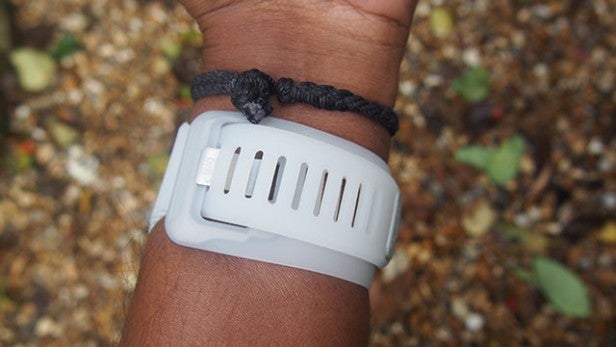Adidas MiCoach Fit Smart Review
Adidas MiCoach Fit Smart
A fitness band for which only serious athletes need apply
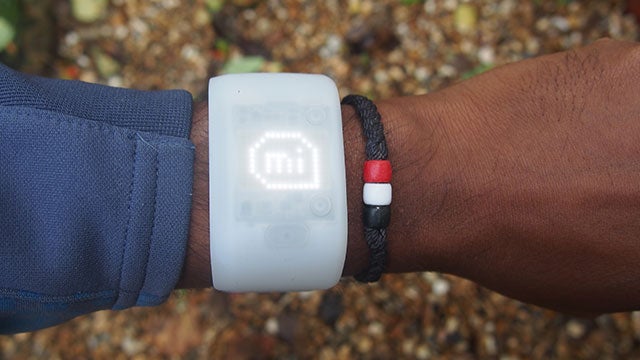
Verdict
Pros
- Great battery life
- Accurate heart rate tracking
- Comfortable to wear
Cons
- Not the most attractive design
- App can be slightly confusing
- Run tracking inaccurate at longer distances
Key Specifications
- Review Price: £145.00
- Built-in accelerometer for run tracking
- Mio continuous heart rate tracking
- Stores 10 hours of data
- Bluetooth 4.0
- 200 mAh battery
What is the Adidas MiCoach Fit Smart?
The Adidas MiCoach Fit Smart is a wrist-worn fitness band squarely aimed at runners and serious athletes. There’s none of the daily activity tracking you get with a Fitbit or a Jawbone band, such as steps or calories burnt, but it does include a heart-rate sensor using the same Mio Alpha-powered technology found inside the TomTom Runner Cardio sports watch.
At £145, it’s significantly cheaper than the GPS-packing Adidas MiCoach Smart Run watch but while it offers some great training plans, serious runners might feel let down by the lack of features that really matter.
SEE ALSO: Best Fitness Trackers
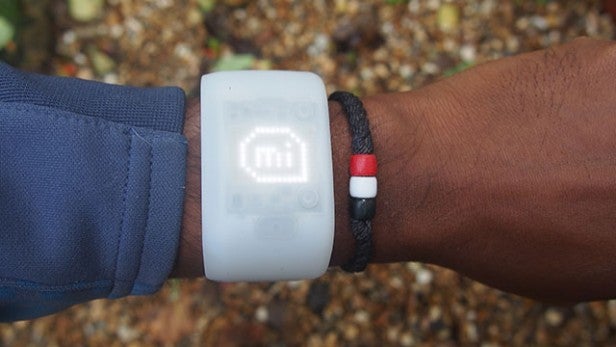
Adidas MiCoach Fit Smart – Design and Features
Out of the box, the Fit Smart looks a little on the big side. It’s halfway between the size of a fitness tracker like a Fitbit Charge and a Garmin Forerunner sports watch. When it’s on, the wraparound design doesn’t feel so bulky and it’s surprisingly light as well. If you did want to wear it all the time, it’s a snug fit with no signs of irritation.
The white, slightly stretchy silicone strap gives it an undeniably robust feel – we had no qualms throwing this into the bottom of a bag. Keeping the Fit Smart around your wrist is a standard watch buckle that offers a more secure fit than most of the fitness bands we’ve tried, like the Charge and the Misfit Flash.
While the miCoach Fit Smart is technically only sweat- and splash-proof, we accidentally walked into the shower a couple of times wearing it without any problems, but we’d suggest not doing that in case you do some damage to the heart-rate sensor on the back. There’s also an optional black version of the Fit Smart that’s a little more low-key than the white one, but crucially both Fit Smart models are available in small (184mm) or large (207mm) sizes so should fit most wrist sizes.
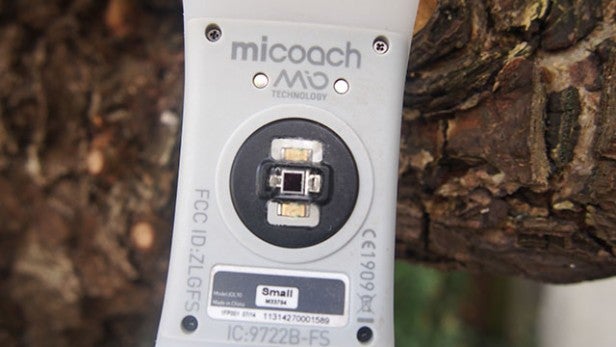
Up front is a sizeable 17×11 LED display, which is about the same width as a finger. The digital interface is reminiscent of the one used by the Nike Fuelband, with its big, bright white numbers making it ideal for night-time use. The illumination doesn’t end there, though. On the left of the display you’ll find a thin LED lightpipe. This is heavily integrated into training, particularly for heart-rate training flashing a series of different colours to indicate performance.
There are three buttons to navigate the display. The larger one switches between time, battery status and selecting the different training modes, while the two on the side take care of scrolling through the MiCoach and free training modes, and provide stats from your last run. Even with a pair of gloves, the buttons are easy to press to get that quick glance at the real-time data.
Around the back is where you’ll find the charging contacts for the proprietary charging cradle and alongside that is the heart-rate sensor. It’s not the first fitness device and certainly won’t be the last that includes heart rate monitor as companies move away from the traditional chest strap monitors to ones you can wear on your wrist. Recording the data is especially important for making sure you’re working hard enough in your workout sessions.
The sensor itself is an optical-based Mio setup, similar to the one used on the TomTom Runner Cardio, using light to detect blood flow from which readings are generated. Heart-rate monitor chest straps apply a different method for measuring the heart’s electrical activity, which is considered more accurate, but Mio’s sensors have proven to offer some similarly accurate readings.
The challenge the Fit Smart’s sensor faces is producing accurate readings while you’re on the move. To combat the interruption of movement, the sensor also uses an accelerometer to provide continuous heart-rate tracking throughout a run or workout.
Adidas MiCoach Fit Smart – App
The MiCoach Train and Run app has been around for some time now. Despite having had a makeover recently, it still a bit of a challenge getting to grips with some of the information. You’ll need an iPhone running iOS 7+ or an Android phone running Android 4.3 Jelly Bean or newer to connect the phone to the Fit Smart via Bluetooth Smart 4.0.
Downloading the app from the respective stores is free and, once you’ve set up an account, there’s a relatively simple user interface to get acquainted with. The dropdown menu on the left provides shortcuts to the different sections. The first section is the quickest way to get tracking. Just press GO when you’re ready to start and it’ll prompt the Fit Smart into action if already synced.
The Devices section is where you sync data and updates to the Fit Smart by holding down the larger button on the device. You can adjust the workout display to decide in which order it displays time, heart rate, calories, distance, pace, average pace, average speed and speed. You can also adjust split readings, which is basically whether parts of your run are divided by time or distance.
Up next is where you can set up weekly goals and training plans. The weekly goals can be focused on motivating you to lose weight, to get fitter for a particular sport or boosting endurance. Training plans are aimed at users who are training for a race, improving general fitness or for optimizing performance for a specific sport. If you have a training plan set up, you can’t have a weekly goal set up at the same time.
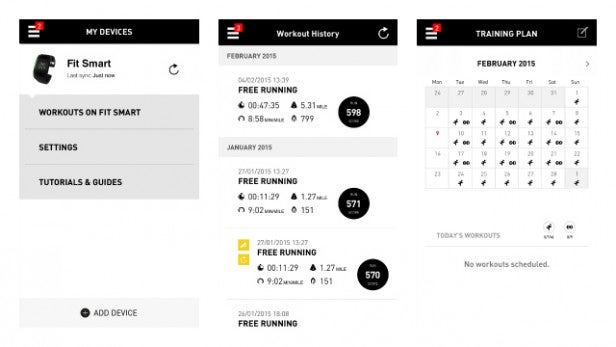
Once you’ve selected a plan, you’ll be asked to input target time and then be given a plan for running, with the option to add a strength plan. You can then sync the data with your phone’s calendar to make sure you’re reminded of which days to train on. Selecting those sessions will push the data to the Fit Smart ready for monitoring and letting you know if you’re keeping up.
In the last section you’ll find workout history and achievements. You’ll be able to see a stream of all of your runs or exercise sessions with the same data you can see on the Fit Smart’s displays. There’s also a Run Score, which helps recommend training race plans and predicted race times for a marathon, half marathon, 10k race and 5k race.
Since we started testing the Fit Smart, Adidas has updated the apps to include links to the Adidas blog, individual stats and a settings section where you can view pace, heart rate and speed zones to make better sense of how hard you’re training when you get into those zones.
For beginners, the MiCoach app is going to feel like a daunting place and we had some frustrating syncing issues early on, which a recent fix appears to have addressed. There are some great features here, especially around building training plans when you first start running specific distances for the first time. We just wish it was a bit more user-friendly and that workout history was presented in a tidier way.
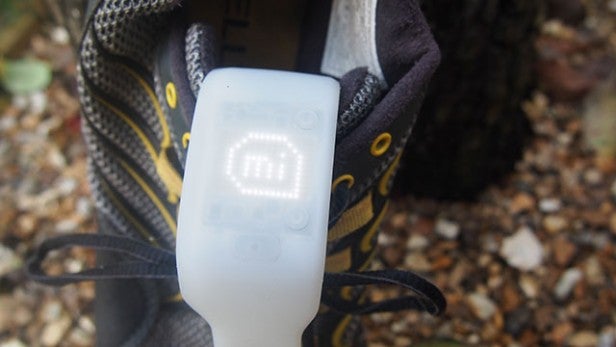
Adidas MiCoach Fit Smart – Performance and Battery Life
We’ve spent a few months training with the Fit Smart and there are some things runners in particular will like and that others will loathe. Movement tracking is done via an accelerometer, which means there’s always going to be a degree of inaccuracy for distance and stride data, especially compared to a GPS watch or a dedicated stride sensor. The GPS solution can also be solved using the integrated phone and Fit Smart, but that does mean carrying another device with you.
We tested it against the GPS-packing TomTom Runner sports watch and the RunKeeper iPhone app, and it was bizarre experience comparing the results during a run. At the beginning of the run, distance tracked was 200-300m out of sync with the Runner and RunKeeper. After 45 minutes, it did begin to level out and deliver distance data that was more consistent with our test devices, but by that point average pace data was skewed by the earlier tracking.
Adidas MiCoach Fit Smart vs TomTom Runner sample data
Adidas MiCoach Fit Smart
Time: 00:47:35
Distance: 5.31 miles
Minutes per mile: 8:59 minutes
Calories: 799 calories
TomTom Runner
Time: 00:47:37
Distance: 5.34 miles
Minutes per mile: 8.54 minutes
Calories: 550 calories
The accuracy problem is a shame, because there are some great features on the Fit Smart, such as the run splits indicator on the light pipe, which sends out a little vibration when you’ve completed a mile or kilometre and illuminates the side of the band with a red, green or blue light. This indicates whether you’ve slowed or quickened in pace and is a great motivational tool when you’re out running.
The lighting system is also used for coached workout zones. Once you’ve selected the MiCoach symbol and selected the AW (assessment workout) option, the lightpipe can also indicate how intense your workout is. White equates to 74bpm (beats per minute), while red means you’re working to 182bpm – and that’s pushing hard. At the same time, the main display will present arrows to dictate whether to pick things up or maintain your pace.
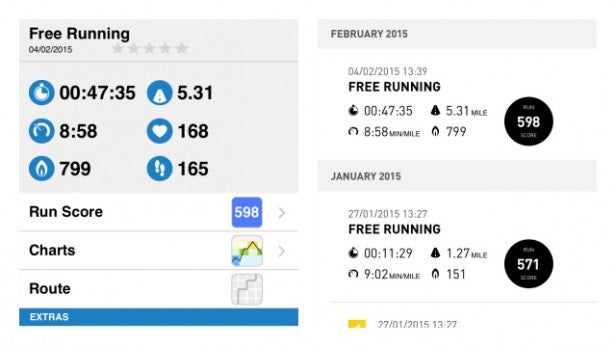
It’s biggest feature is the heart-rate tracking and we were pleasantly surprised to see that it performed very well. Putting it up against the Polar H7 heart-rate monitor chest strap and the Jabra Pulse Wireless heart-tracking headphones, accuracy even at more intense levels of workout were accurately tracked, with a 1-2bpm difference on the odd occassion. It wasn’t all good from a continuous tracking perspective, as there was the odd dropout. It usually recovered after 30 seconds, and whether that was down to the fit of the Fit Smart’s sensors losing contact with our wrist because of poor fit, it wasn’t really clear.
One thing you shouldn’t really have to worry about is battery life. Adidas claims up to five days of use, but if you’re using it sporadically over a week, you can comfortably get a few days longer. We’ve also had it sitting in our bag unused for a few days and there was very little drop-off, which can be the case with some fitness bands. That’s because it automatically powers off after ten seconds. When battery’s running low, the light pipe will glow red, which unfortunately means reaching for the docking cradle. The cradle’s compact but can take up to three hours to get the Fit Smart fully charged.
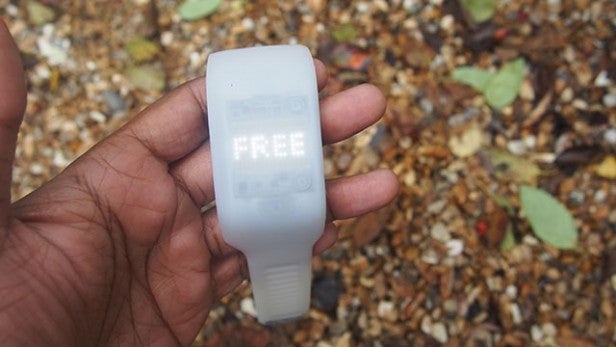
Should I buy the Adidas MiCoach Fit Smart?
Casual activity trackers should stay away, but if you’re a mostly short-distance runner or already keen on keeping fit, then the Fit Smart is going to appeal both from a device and software perspective. It’s comfortable to wear and easy to use, while the accelerometer and heart rate monitor generate mostly accurate readings.
For £145, it’s both surprising and disappointing that it doesn’t have the basic activity-tracking features available, especially when we’d imagine it wouldn’t take much to include them. For an extra £50 you could get a similar setup like the TomTom Runner Cardio GPS-packing watch, although the Cardio isn’t as slim or nor can it really match the MiCoach’s in-depth training software.
If Adidas perseveres with the Fit Smart, and brings out a new one in the future, GPS would make it a killer fitness band for runners. Right now, though, the Fit Smart just needs to be smarter.
Verdict
The MiCoach Fit Smart might not be the ultimate running band, but there’s still plenty to make it a decent training aid.


